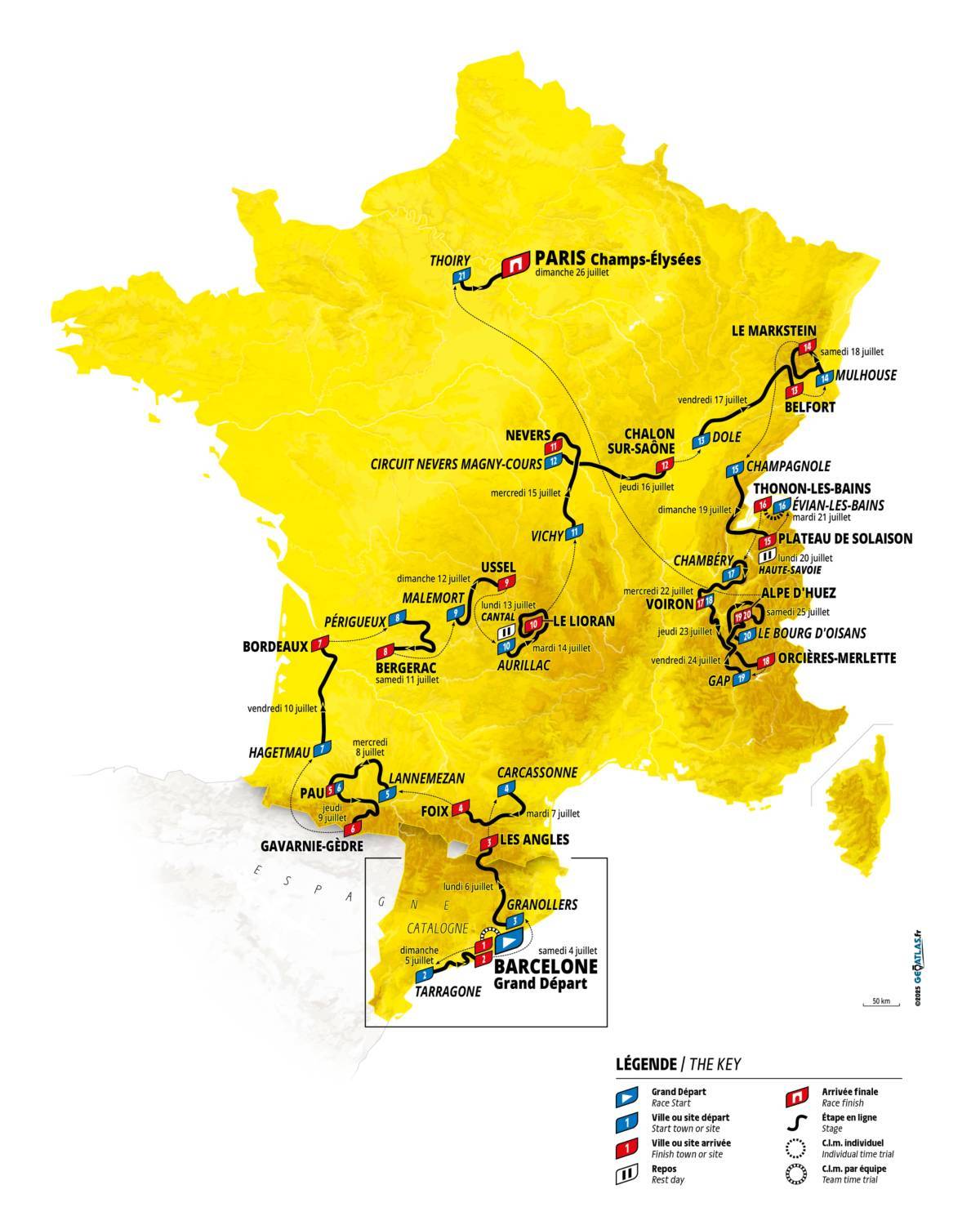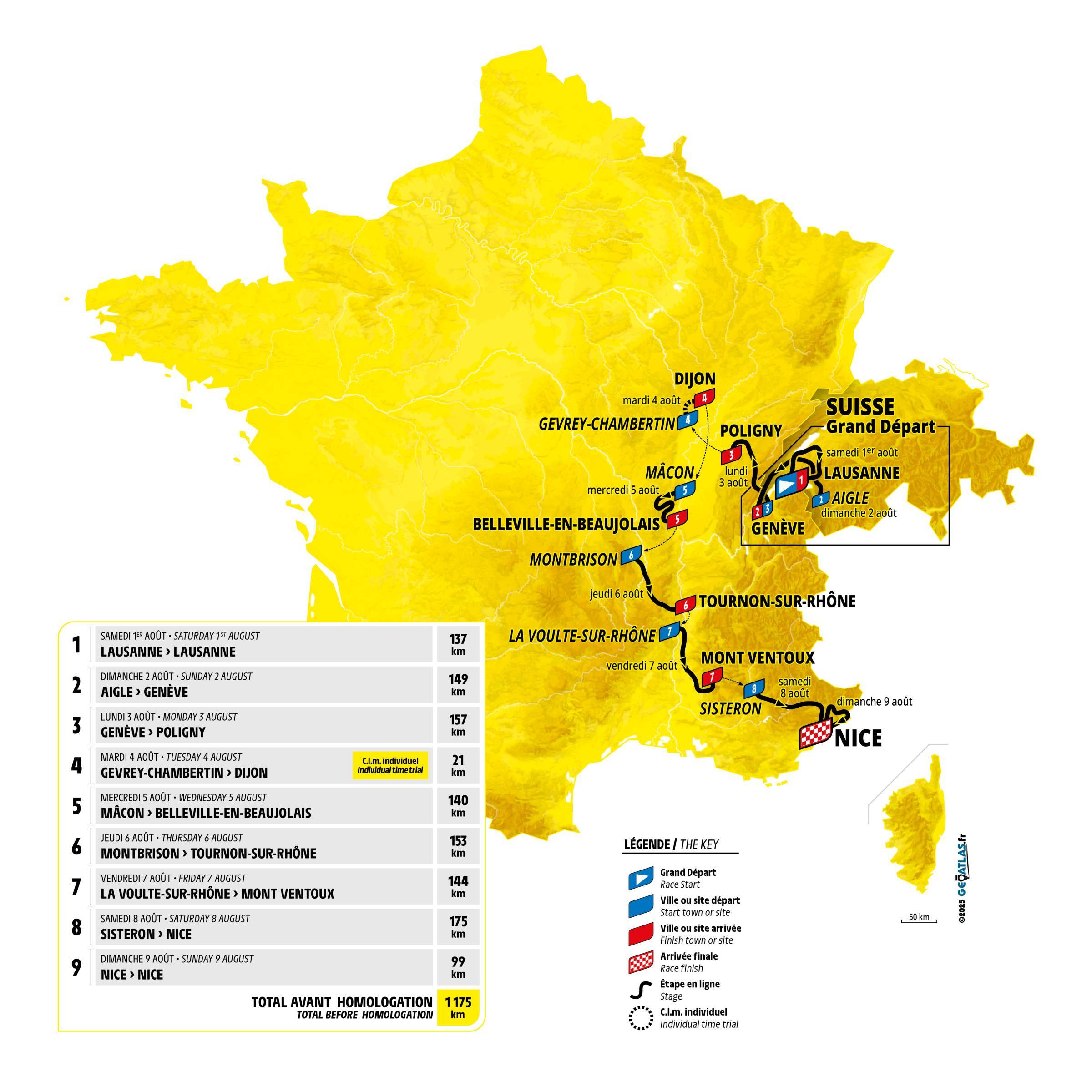
Tadej Pogacar’s chances of winning a record-equalling fifth Tour de France title have only increased after the 2026 race route was revealed in Paris on Thursday, with back-to-back summit finishes atop Alpe d’Huez set to make or break the general classification.
The battle for the yellow jersey may start as early as stage three, with a summit finish atop the ski station at Les Angles. A climbing-heavy second week through the Massif Central and Vosges ranges leads into a blockbuster Alpine final week, including two summit finishes on Alpe d’Huez on stages 19 and 20, before a long transfer to Paris for the final day’s racing.
As expected, the tricky, cobbled Montmartre addition to the usual iconic Champs-Elysees finishing circuit in Paris is here to stay after a well-received trial run in 2025 - albeit with a twist, as the final climb comes 15km from the finish rather than 6km as it was this summer.
Those two ascents of Alpe d’Huez will be tackled differently: stage 19 runs from Gap and tackles three lesser climbs before the big one, while stage 20 is even more fearsome, with four Tour behemoths – the Croix de Fer, the Col du Télégraphe, Col du Galibier, and Col de Sarrene – and over 5,000m of elevation gain to surmount en route in a stage that could shake up the yellow jersey standings entirely.
At 2,642m above sea level the Galibier will once again be the Tour’s highest point, while the Sarrene will be approached from its south-eastern side for the first time.
The 2026 Tour will run from 4-26 July, with its Grand Départ to take place in Barcelona and opening three stages in Spain. The Catalan capital will host an opening 19km team time trial – the first time the race has opened with a TTT since 1971 – and the start of a rolling road stage to Tarragona on stage two.
The sprinters will get their first chance at glory on stage five, a 158km run from Lannemezan to Pau, another on stage seven in Bordeaux, with a lengthy wait before a trio of opportunities on stages 11, 12 and 13 and a final outing on stage 17 in Voiron. In total seven stages are classified as flat, four as hilly, and eight as mountainous, with five of those featuring summit finishes.
The route is also slightly different from normal in its emphasis on slightly shorter stages, with only one over 200km: stage 13’s 205km run from Dole to Belfort.
In total, the riders will tackle 54,450m of elevation gain across 3,333km.
The race will only feature one individual time trial, stage 16’s 26km run from Évian-les-Bains to Thonon-les-Bains. 10km of that will be uphill before a descent into a flatter finale, a development that will likely help Pogacar avoid any serious time losses to TT specialists like Remco Evenepoel.
Stage 10 will be a serious climbing test with seven ascents in the Massif Central en route to Le Lioran, which returns two years after Jonas Vingegaard memorably caught Pogacar in a dramatic sprint finish there. Other major mountains include stage 15’s Plateau de Solaison, which makes its Tour debut in the concluding stage of week two, and the Orcières Merlette summit finish on stage 18.

Both the men’s and women’s routes were unveiled in Paris’ Palais des Congrès in Paris on Thursday.
The Tour de France Femmes 2026 will take place from 1-9 August, with a wholly separate slot in the calendar to the men’s race.
Its Grand Départ will take place in Switzerland with a pair of flat stages for the sprinters. It is the second time the race will begin outside France, after Rotterdam hosted last year’s Grand Départ.
After a rolling stage three from Geneva to Poligny the race then hops across to Gevrey-Chambertin in France for stage four’s 21km time trial to Dijon, which may lend itself more to a GC rider than a TT specialist due to the presence of a rise in the middle of the stage, before a pan-flat final 3km.
Stages five and six are littered with short, spiky climbs which pepper the course as a whole; this year’s route is notable for having fewer major Alpine passes than in previous years and more Classics-style climbing days.

The highlight of the route is stage seven’s trip to one of the Tour’s most infamous climbs, Mont Ventoux, which features in the women’s race for the first time.
The iconic Giant of Provence will be approached via a long and largely flat route from La Voulte-sur-Rhône, similar to the design of the Mont Ventoux stage in the men’s Tour this year. The queen stage of this year’s race features 3,565m of elevation gain on the 144km run, with the summit finish atop Ventoux likely to be pivotal in the general classification standings in the absence of any other significant mountains.
After two heavily backloaded editions of the race, with much of the toughest climbing on the final day, the riders this time will have a slightly more mellow finale. Stage eight is a long 175km run from Sisteron to Nice – the longest stage of the race – while stage nine is a punchy 99km loop starting and finishing in Nice, essentially consisting of four times up and down the major Paris-Nice climb of the Col d’Eze with little time to recover between each ascent.
Despite the lack of Alpine monster climbs compared to previous races the 2026 edition nonetheless features a record 18,795m elevation gain in total, across the Jura, Massif Central and Alps.
Frenchwoman Pauline Ferrand-Prevot won a thrilling edition of the Tour de France Femmes this summer, and the reigning champion is likely to resume her duel with fellow podium finishers, 2023 winner Demi Vollering and 2024 champion Kasia Niewiadoma, next August.







